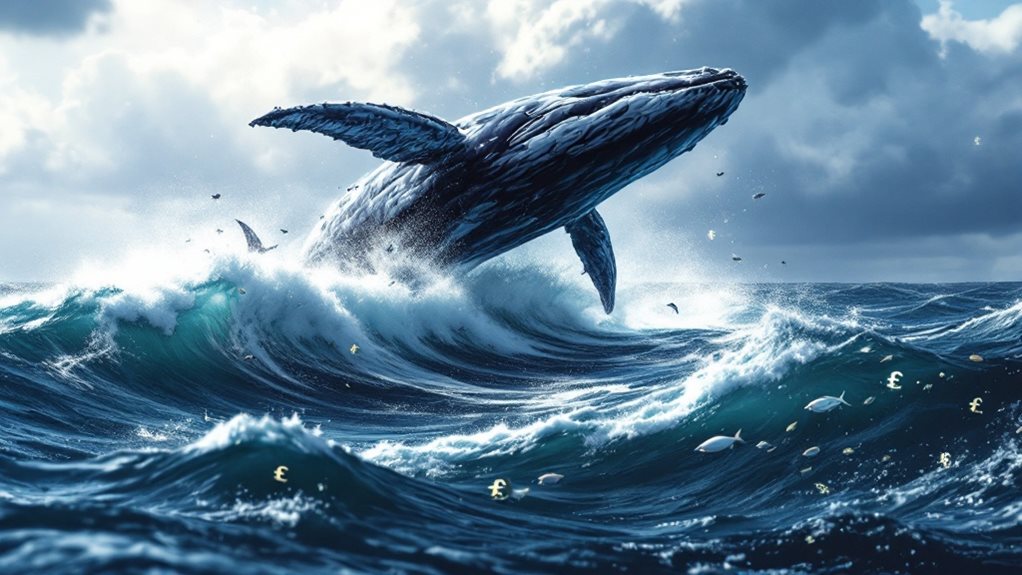A crypto whale is someone who owns massive amounts of cryptocurrency – enough to impact market prices when they buy or sell. These powerful players can be individual investors, companies, or organizations holding large quantities of digital coins. While there's no fixed amount that defines a whale, owning over 1,000 Bitcoin is a common threshold. Whale activity is closely watched since their trades can create ripples throughout the entire crypto market.

A crypto whale is a powerful player in the cryptocurrency world who owns an enormous amount of digital currency. As of August 2024, four wallets control 3.56% of all Bitcoin in circulation. While there's no specific amount that officially makes someone a whale, these large holders typically control enough cryptocurrency to make waves in the market when they make their moves. For Bitcoin, any wallet containing over 1,000 BTC is considered a whale. They can be individual investors, big companies, or organizations that have accumulated significant holdings over time.
What makes crypto whales particularly interesting is their ability to influence the market. When they buy or sell large amounts of cryptocurrency, it can cause dramatic price changes. Think of it like throwing a big rock into a small pond – the splash creates ripples that affect everything around it. That's why other investors and traders keep a close eye on what these whales are doing.
These massive cryptocurrency holders don't always trade like regular investors. They often use special over-the-counter trading services to buy and sell their holdings. This helps them avoid causing too much disruption in the regular market. Some whales are known to stay inactive for long periods, holding onto their cryptocurrency without making any moves. According to market data, these whales collectively control 12-15% of total supply in the highest tier of cryptocurrency holdings. High market capitalization cryptocurrencies tend to attract more whale activity due to their better liquidity and trading opportunities.
The crypto community has developed various ways to track whale activity. Special blockchain explorer tools let people watch for large transactions, and services like Whale Alert notify users when significant amounts of cryptocurrency move between wallets. Social media channels often light up with discussions when whales make big moves, as traders try to figure out what these actions might mean for the market.
Whales don't just affect prices – they can influence other aspects of the cryptocurrency ecosystem too. Their large holdings might give them voting power in blockchain governance decisions, and their trading patterns can impact how easily others can buy or sell cryptocurrency. When a whale makes a move, it often creates a ripple effect as other investors react to their decisions.
The cryptocurrency market has become increasingly sophisticated in monitoring whale behavior. Analytics companies have created specialized tools to track and analyze whale movements, and many traders use this information as part of their trading strategies.
However, it is essential to recognize that whale watching isn't a guaranteed way to predict market movements, as these large holders' intentions aren't always clear. They remain mysterious figures in the crypto world, wielding significant influence while often staying anonymous.
Frequently Asked Questions
How Can Regular Traders Protect Themselves From Whale Manipulation?
Regular traders can protect themselves from market manipulation by spreading their investments across different cryptocurrencies. They won't put all their eggs in one basket.
Many traders use stop-loss orders to limit potential losses and monitor trading volume for unusual activity. Staying informed about market news and joining trading communities helps spot manipulation patterns.
Keeping emotions in check and focusing on long-term strategy, rather than reacting to short-term price swings, is common practice.
What Tools Can Help Track Whale Movements in Cryptocurrency Markets?
Several tools help track large cryptocurrency movements.
Blockchain explorers like Etherscan and Solscan show transactions publicly. Whale Alert sends notifications about big transfers across different blockchains.
Specialized platforms like Nansen and Arkham Intelligence analyze wallet patterns. DeFi trackers such as DeBank monitor protocol activity.
Most basic tracking tools are free, but advanced features often need paid subscriptions. Data aggregators combine information from multiple sources for thorough monitoring.
Do Crypto Whales Communicate With Each Other Before Making Major Moves?
Crypto whales often communicate with each other through private channels.
They use encrypted messaging apps like Signal and Telegram, plus exclusive online forums and Discord servers. They also meet in person at crypto conferences.
While it's hard to prove, there's evidence of whales coordinating their trading moves. This includes suspicious trading patterns and leaked chat logs.
However, because they use private channels, most of their communications stay hidden.
How Long Does It Typically Take to Become a Cryptocurrency Whale?
The time to become a crypto whale varies greatly based on several factors.
With a large initial investment, someone can become a whale immediately.
For those starting with smaller amounts, it typically takes 5-10 years through regular investing.
Early crypto adopters often became whales within 1-3 years, while successful traders might take 2-5 years.
Market conditions, chosen cryptocurrencies, and investment strategy all play key roles in the timeline.
Are Crypto Whales Required to Report Their Holdings to Regulatory Authorities?
The reporting requirements for crypto whales aren't consistent worldwide. It depends on where they live and what rules apply there.
In some countries, large crypto holders don't have to report anything. In others, they must disclose their holdings to authorities.
The U.S. requires reporting crypto transactions for tax purposes, while countries like Japan and South Korea have specific rules for large crypto transactions.
Many whales use multiple wallets, making tracking difficult.





